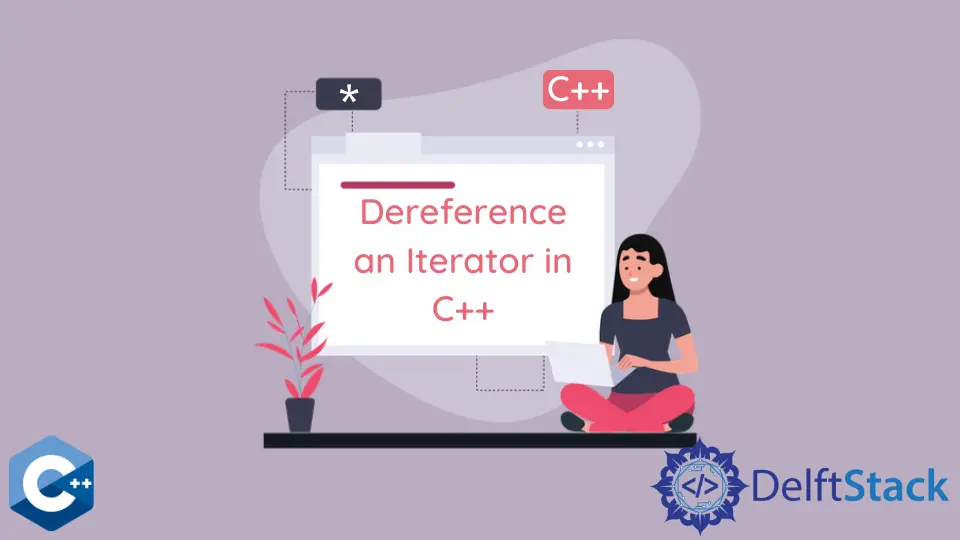C++ でイテレータを逆参照する

イテレータは、C++ のもう 1つの強力なメカニズムであり、配列など、内部に要素のインデックスがないツリーやセットのような複雑なデータ構造を反復処理するのに役立ちます。
C++ の反復子とは
C++ では、反復子はポインターのようなオブジェクトであり、配列、リスト、およびその他のデータ構造内の要素を指します。 コンテナー要素を反復するために反復子を使用します。 従来のループを使用することもできますが、イテレーターはコンテナーの反復処理において優位に立っています。
コンテナの要素をトラバースするための非常に一般的なアプローチを提供します。
配列のような一般的なデータ構造では、インデックス変数を使用してコンテナーをループできますが、ループするインデックス変数がないツリーや順序付けられていないデータ構造などの高度なデータ構造では、イテレーターを使用してそれをトラバースします。 .
コンテナはイテレータにデータ型を提供し、コンテナ クラスはイテレータがコンテナの要素を繰り返し処理するのに役立つ 2つの基本的な関数を提供します。
Begin()- コンテナの最初の要素を返します。End()- コンテナの最後の要素の次の要素を返します。
適切なコード例を通して理解しましょう。
#include <iostream>
#include <vector>
using namespace std;
int main() {
// Declaring a vector
vector<int> numbers = {1, 2, 3, 4, 5};
// Declaring an iterator
vector<int>::iterator i;
int j;
cout << "Traversing using loop = ";
// Accessing the elements using loops
for (j = 0; j < 5; ++j) {
cout << numbers[j] << ", ";
}
cout << endl << "Traversing using Iterators = ";
// Accessing the elements using iterators
for (i = numbers.begin(); i != numbers.end(); ++i) {
cout << *i << ", ";
}
// Adding another element to the vector
numbers.push_back(6);
cout << endl << "Traversing using loops after adding new value to numbers = ";
// After adding a new value to the numbers vector
for (j = 0; j < 5; ++j) {
cout << numbers[j] << ", ";
}
cout << endl
<< "Traversing using iterators after adding new value to numbers = ";
// Accessing the elements using iterators
for (i = numbers.begin(); i != numbers.end(); ++i) {
cout << *i << ", ";
}
return 0;
}
出力:
Traversing using loop = 1, 2, 3, 4, 5,
Traversing using Iterators = 1, 2, 3, 4, 5,
Traversing using loops after adding new value to numbers = 1, 2, 3, 4, 5,
Traversing using iterators after adding new value to numbers = 1, 2, 3, 4, 5, 6,
このプログラムは、ループと反復子を使用してコンテナーを通過する使用方法の違いを示しています。 上記のコードでは、反復子はコードを追跡し、コードに変更が加えられた場合に動的に適用します。
ループ中は、ループ用のコードを静的に更新する必要があります。 イテレータは、コードの再利用率を達成しています。
イテレータでは、begin() 関数がコンテナの最初の要素を取得し、end() が最後の要素の次の要素を取得します。
C++ での逆参照
C++ の逆参照演算子は、ポインターが指すメモリ位置のデータにアクセスまたは操作するために使用されます。 * アスタリスク記号 は、ポインター変数を差分するときにポインター変数と共に使用され、ポインターの逆参照と呼ばれる、ポイントされた変数を参照します。
コード例:
#include <iostream>
using namespace std;
int main() {
int a = 9, b;
int *p; // Un-initialized Pointer
p = &a; // Store the address of a in pointer p
b = *p; // Put the Value of the pointer p in b
cout << "The value of a = " << a << endl;
cout << "The value of pointer p = " << *p << endl;
cout << "The value of b = " << b << endl;
}
出力:
The value of a = 9
The value of pointer p = 9
The value of b = 9
最初に a に 9 を代入し、次にポインター p を定義します。 次にポインタであるpにaのアドレスを代入し、最後に整数データ型の変数bにポインタを代入します。
表示すると、a、p、および b は 9 と同じ出力を得ています。これは、p が a のアドレスを持っているためです。これは、どこでも使用して a の値を表示するのに役立ちます。
C++ で反復子を逆参照できない理由
C++ では、end() 関数がイテレーターとオブジェクトをポインターとして返すため、イテレーターをすぐに逆参照することはできません。これはデータ構造の有効なメンバーではありません。
最後に逆参照すると、エラーがスローされます。これは、エンド ポインターの目的は、いつ到達したかを確認することだけであるためです。
Begin()は、コンテナが空でない場合、つまりこの条件を満たす場所を返します。
v.begin() != v.end() // this condition checks, if the container is empty or not
ただし、最後の要素にアクセスする必要がある場合は、以下のコードを使用できます。
vector<object>::const_iterator i = vectorOfObjects.end();
i--;
cout << *i << endl; // this prints the last element of the container
注意として、このコードは、ベクターに少なくとも 1つの要素が含まれている場合にのみ機能します。
コード例:
#include <iostream>
#include <string>
#include <vector>
using namespace std;
struct Student {
int roll;
string name;
int age;
};
int main() {
Student s1, s2, s3; // Objects of strucu
vector<Student> ListOfStudents;
s1.roll = 1; // populating the data members of Student
s2.roll = 2;
s3.roll = 3;
s1.name = "Mike";
s2.name = "John";
s3.name = "Tom";
s1.age = 15;
s2.age = 16;
s3.age = 14;
ListOfStudents.push_back(s1);
ListOfStudents.push_back(s2);
ListOfStudents.push_back(s3);
vector<Student>::const_iterator iter =
ListOfStudents.begin(); // begining position
while (iter != ListOfStudents.end()) { // if the container is empty or not
cout << "Roll number " << iter->roll << " is " << (*iter).name
<< " and he is " << iter->age << " years old." << endl;
++iter;
}
return 0;
}
出力:
Roll number 1 is Mike and he is 15 years old.
Roll number 2 is John and he is 16 years old.
Roll number 3 is Tom and he is 14 years old.
Zeeshan is a detail oriented software engineer that helps companies and individuals make their lives and easier with software solutions.
LinkedIn